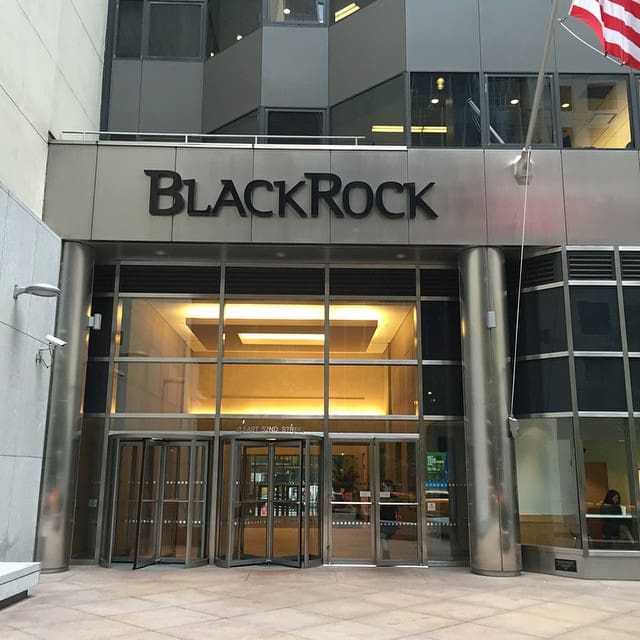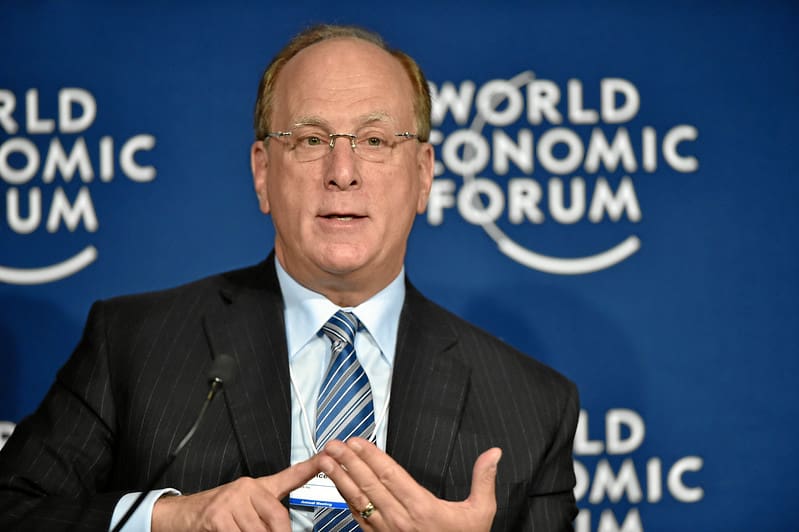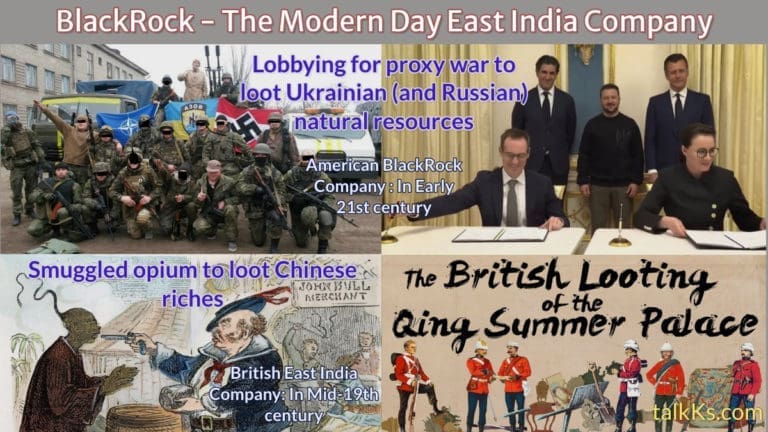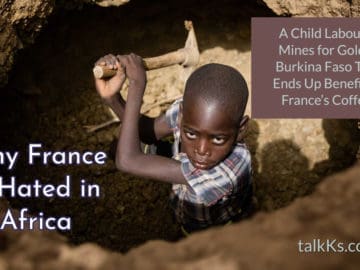Table of Contents
In the world of global finance, few names hold as much weight as BlackRock. This article dives into the journey of BlackRock, tracing its beginnings, rapid growth, and how it’s become entwined with political power. We’ll also explore its unexpected involvement in Ukraine’s recovery efforts during ongoing geopolitical tensions. Additionally, we’ll draw parallels between BlackRock and historical entities like the East India Company, raising questions about its influence today. Join us as we explore BlackRock’s story and its potential impact on the world economy.
BlackRock: From Inception to Global Dominance
BlackRock’s beginnings were rooted in another financial powerhouse, BlackStone. In 1988, Larry Fink established BlackRock in partnership with seven colleagues as an internal division dedicated to asset management under the umbrella of Blackstone. Remarkably, the venture swiftly achieved profitability within a short span of time. By 1989, the collective assets managed by the group had surged fourfold, reaching an impressive valuation of 2.7 billion dollars. This extraordinary rise can be attributed to the pivotal role played by two groundbreaking advancements – Exchange Traded Funds (ETFs) and Aladdin, the proprietary trading algorithm meticulously developed by BlackRock. ETFs allow investors a simple and efficient way to diversify their investments while reducing risk and costs. Aladdin serves as BlackRock’s risk management system, functioning as a digital brain to track portfolios and manage risk by predicting the likelihood of a specific investment failing.

BlackRock’s big break came in 1995 when it was acquired by PNC Financial Services Group, a bank based in Pittsburgh. PNC saw BlackRock’s expertise in fixed-income securities as a valuable asset and wanted to expand its asset management business. With PNC’s backing, BlackRock expanded rapidly, acquiring other asset management firms and entering new markets. In 1999, BlackRock made a major move by acquiring State Street Research and Management, a Boston-based asset manager with a strong presence in the mutual fund market. This acquisition gave BlackRock access to State Street’s distribution network, helping it grow its assets under management.
Throughout the 2000s, BlackRock continued to expand, acquiring other asset managers and introducing new investment products. In 2006, the company launched its iShares ETF platform, which quickly became a leader in the ETF market, solidifying BlackRock’s position as one of the largest asset managers globally.
In 2009, BlackRock made its biggest acquisition by purchasing Barclays Global Investors for $13.5 billion. This acquisition made BlackRock the largest asset manager in the world, with over $2.7 trillion in assets under management. It also gave the company control of iShares, which became the largest ETF provider globally.
Most importantly, BlackRock’s influence has grown through significant opportunities in times of financial crises, such as during the 2008 financial crisis when the firm took over assets of major collapsed banking institutions like Bear Stearns and AIG. In 2020, BlackRock was again tapped to help stabilize the bond market amid the economic turmoil caused by the coronavirus pandemic.

BlackRock presently stands as the largest among the trio of investment firms, overseeing an impressive sum of nearly $10 trillion in assets. Vanguard follows with approximately $8 trillion, trailed by State Street at $4 trillion. These substantial assets, attributed to investors who are BlackRock’s clients, essentially translate to BlackRock’s management or ownership of the entire portfolio. In fact, this number surpasses the entire Gross Domestic Product of most of the countries in the world.
Functioning like a giant octopus, BlackRock extends its influence into diverse sectors, including oil and gas, technology, and healthcare. As a significant shareholder in some of the world’s largest corporations, BlackRock wields substantial influence over their strategic choices. This permeates BlackRock with a pervasive presence in virtually every facet of our lives – from the fuel powering our vehicles to the gadgets we use and the financial institutions we entrust our resources to.

This concentration of ownership has led to concerns over monopolistic behavior.
The ownership of shares in supposedly competing firms by the same few investment companies, like BlackRock, creates a different form of monopoly, harming competition, consumers, and the economy. This pattern of concentrated institutional ownership is observed across major industries, impacting everyday life and even influencing major corporate decisions.
BlackRock: FAQ
Who is the current BlackRock CEO?
Larry Fink is the individual behind BlackRock. He is the Founder, Chairman, and Chief Executive Officer of the company.
Who are the 7 founders of BlackRock?
The 7 founders of BlackRock include Larry Fink, Keith Anderson, Ben Golub, Ralph Schlosstein, Barbara Novick, Hugh Frater, Susan Wagner, and Robert S. Kapito.
What companies are owned by BlackRock?
BlackRock owns (voting) significant number of shares in some of the most well-known companies in the world, including Apple, Microsoft, Amazon, Nvidia, Google, Tesla, UnitedHealth Group, Meta, and Berkshire Hathaway.
What does BlackRock deal with?
BlackRock is mainly engaged in asset management, overseeing a vast portfolio of investments across different sectors, including media, technology, healthcare, energy, communications, and finance.
Does BlackRock own companies in Russia?
BlackRock owns shares in several companies in Russia, including Gazprom, Rosneft, Sberbank, VTB, Transneft, Alrosa, Lukoil, Tatneft, Novatek, and Nornickel. However, due to Russia’s ongoing conflict with Ukraine, BlackRock has incurred a substantial loss of $17 billion on its funds exposed to Russian equities. As of January 2021, BlackRock held more than $18.2 billion in Russian assets. Currently, many of its funds are frozen due to market conditions and sanctions imposed by Russia on US companies and also the US and its allies on Russian companies.
BlackRock’s Impact on Politics and Government Relationships
BlackRock’s rise to power was carefully and methodically orchestrated over time, intertwining its influence with political power and giving it the ability to choose winners and losers. This control and concentration of institutional ownership raise concerns about its impact on the quality of life for ordinary people. In fact, their strategic playbook involves campaign contributions, building connections with both major political parties, and specifically targeting the House Financial Services Committee, which could potentially influence BlackRock’s interests. Additionally, the company employs a substantial number of professional lobbyists to advocate for its positions in government. These efforts further solidify BlackRock’s influence and presence in high-ranking government positions, with former employees now holding key roles in the Biden administration, raising questions about potential conflicts of interest and financial institutions’ control over decision-making processes.

At the time of this writing, BlackRock’s influence has extended high up into the US government, with three of its former employees holding appointed positions in the Biden administration. Brian Deese, the former Global Head of Sustainable Investing at BlackRock, is now Biden’s Chief Economic Director. Mike Pyle, BlackRock’s former Global Chief Investment Strategist, serves as Kamala Harris’s Chief Economic Advisor. Both of these positions do not require Senate confirmation. Furthermore, Wally Adeyemo, formerly the Chief of Staff to BlackRock CEO Larry Fink, currently serves as the Deputy Treasury Secretary.
Moreover, Larry Fink, the Chairman and CEO of BlackRock, is a member of the Board of Trustees of the World Economic Forum. This deep integration into political and economic circles has raised concerns about the extent of the firm’s influence.

The presence of BlackRock veterans in such high-ranking government positions has drawn attention, with some questioning the potential conflicts of interest and the level of control that financial institutions like BlackRock have over government decision-making processes. This level of influence has prompted discussions about the roles and impact of financial institutions, hedge funds, and banks in shaping economic policies and regulations.
BlackRock’s Role in Ukraine
Amidst the challenges faced by Ukraine due to the ongoing conflict with Russia, Ukrainian President Volodymyr Zelensky has enlisted the help of BlackRock to attract private and public investments for the reconstruction of Ukraine’s economy, which has been affected by the war. The Ukraine Development Fund, with the assistance of these firms, aims to mobilize capital from various investors. On the surface, this might seem like a positive step—after all, who better to rebuild an economy than some of the biggest names in global finance? But as we peel back the layers, we start to see a more complex picture.
Some financial investors view this as a profitable opportunity, seeing potential in Ukraine’s post-war future. However, the release of a video by O’Keefe Media Group unveiled recently shed light on the work dynamics of BlackRock. The content of this video, featuring a conversation between BlackRock recruiter Serge Varlay and an undercover journalist from OMG News, provides an unexpected connection to the situation in Ukraine.







Comments 0